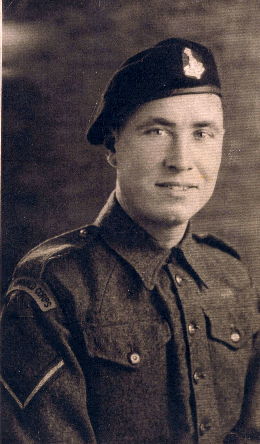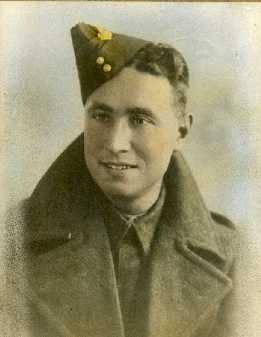 Trooper
4396237 Leonard Arthur Favell
Trooper
4396237 Leonard Arthur Favell Trooper
4396237 Leonard Arthur Favell
Trooper
4396237 Leonard Arthur Favell
1st King's Dragoon Guards, Royal Armoured Corps
Leonard Arthur Favell of the 1st Kings Dragoon Guards, was my Great Uncle, my Grandfather's brother. Uncle Len died on Thursday the 22nd June 1944 while serving in Italy. His grave is in the Assisi War Cemetery.
In June 1944 the Germans were making their first attempts to stop the Allies advance North of Rome. There was heavy fighting in the areas around Perugia and Assisi where he is buried and the Allies suffered a high number of casualties while facing crack regiments of German troops. Len enlisted on the 1st May 1944 and was posted to the 50th Battalion, the Green Howards at Ripon in Yorkshire. He was transfered to the 12th Battalion Green Howards, a Reconnaissance (Recce) Battalion which in 1942 then became 161st Regiment of the Royal Armoured Corps. Recce Regiments operated in armoured cars and would very much be the spearhead of any advance. A history of the Recce corps is entitled "Only the enemy in front (every other bugger behind!)" He attended a wireless and gunnery course at Scarborough and in February 1943 passed the standard test for 'gunner opertaor group C, Class III'. By late 1943 he was training at Trowbridge in Wiltshire and on the 13th December he embarked with the British North Africa Force, landing in Italy on Christmas day.

On 29th april 1944 he was reposted to the King's Dragoon Guards, an armoured regiment who had previously been in action in North Africa. Landing on the beaches at Salerno the allied armies endured a long and protracted fight up the mountainous spine of southern Italy. The German defenders fell back to a fortified and well defended line that cut across the country and centred on Monte Cassino. Between January and March 1944 there were four battles of Monte Cassino before the 'Gustav' line as it was known was finally broken and the allies made for Rome which fell on the 4th June, just two days before D Day. Hitler was forced to send four fresh divisions of reinforcements to Italy at this crucial point.
The fighting in Italy was slow progress in the hills and mountains, clearing each village and vantage point before proceeding. The German troops fought for every inch and when they fell back under the cover of darkness often left mines and booby traps for the advancing allies. Tanks and other armour often had to be separated from the infantry due to the torturous mountain roads and supplies were often brought in by mule train. In a letter home Len described it as "hard going alright….mostly on foot too, we don't have a lot of chance to use our armoured cars….I have met a couple of my pals since I have been here and there are a couple of them with me….I have never been in so many different houses in my life since I have been here, some queer places too, of course we sleep in the open a lot too , but we are on the move all the while slowly but surely if you know what I mean" The letter, to his brother Sidney, was dated the 25th May 1944 and sent from "D Squadron, !st Kings Dragoon Guards, CMF."
An article entitled "A British soldier remembers" by Ronald Arthur Tee, describes the authors own experiences advancing through Italy as part of a reconnaissance corp: -" Another town, similar situation. We were supposed to find out if the Germans still occupied it or not. Now this town was on a very, very steep high hill and the road up to it was very, very steep. I mean REALLY steep. In fact, it was so steep that the road wound from left to right to left to right to make the grade. I was in the lead car as usual and I noticed that every time we made a sharp right hand turn our vehicles were exposed to the town. After moving up this road for a while, I began to think that maybe the German's had left the town because nobody was opening fire on us. Anyway, I was taking my time because I was walking in front of my car looking for land mines. I found about twelve of them on the way up, all buried in the road. I dug them up and threw them in the ditch. All this time, coming through on my radio from the Commanding Officer way down below, was - "What's happening?", ... "Push on!", ... "Push on!", ... "There's nobody in that town!", ... "Nobody is in there!", ... "Push on!" Well, they all think that they're the bosses. There was only one boss here, and that was me, .... and I was going to do it my way! So slowly we made our way up the hill with all the rest of the squadron behind us in different positions."
On the 22nd June the Kings Dragoon Guards were in action near Monte Buono directly overlooking Lake Trasimene. There was fierce fighting and man German counter attacks in the area. It ws said that Len died when the vehicle he was travelling in went over a mine. His army record simply states that he died of woulds. Mines were a constant hazard to the advancing troops and armoured cars were particularly vulnerable.
Ronald Arthur Tee describes what was possibly a similar incident "…I was trailing along in the rear. The lead Commander went through a cross road that was heavily mined. He didn't spot them but was lucky enough not to set any off. The second car, a heavy, hit a mine, turned right over and hit another. Three killed and one badly injured,"
Len's medal entitlement is listed as the 1939-45 war medal, 1939-45 Star, Italy Star & Defence medal
Return to Favell family history WW2